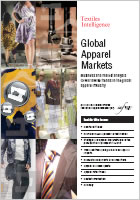Issue
3:
3rd Quarter 2008

Product Overview
Buy this Report now
Buy this Issue now
Subscribe
Download brochure (PDF)
Download price list (PDF)
Price list download
| Please choose your preferred currency:
|
Request sample issue
View list of reports
in other issues
|
Multi Report Package |
We also offer a flexible subscription product,
the Multi Report Package,
which allows you to select your own choice of reports from our full range,
to suit your own budget.
Click here for full details.
|
|
 |
Introduction to radio frequency identification (RFID) in apparel |

6 pages,
published in Issue 3, 3rd Quarter 2008
Report price:
Euro 275.00;
US$ 365.00
|
Radio frequency identification (RFID) systems provide a method of automatically identifying, locating and tracking manufactured products over distances of up to several hundred metres.
They are most commonly used in the apparel industry in conjunction with inventory management systems to track the whereabouts of individual items of clothing.
An RFID system comprises three main components, namely:
- electronic tags;
- an RFID reader; and
- RFID inventory management computer software.
Electronic tags are attached to items of stock. Each tag is digitally-coded with information about the item?s characteristics, such as its size, colour, price, age and/or date and country of manufacture.
Tags can also be attached to a box, or batch, of items. Such tags contain information about all the items in the batch, including the total number of items contained within the batch.
The information in the tags is then picked up on an RFID reader via radio waves. The reader gathers data from the tags by transmitting and receiving radio frequency signals to and from the electronic tags.
The data collected on the RFID reader are then accumulated and presented to the user via RFID inventory management computer software. The software, which creates a central database of information, enables users to refresh, update, read, analyse and react to data which have been gathered.
|
 |
